
Honda NSX Coupe (2016-2023) engines, drive and performance
.jpg)
- One petrol engine, three electric motors
- Total output is 573hp and 646Nm
- 0-62mph in ‘less than three seconds’
Helping this Honda stand out among rivals, as well as being key to its driving experience, is the highly complex hybrid powertrain. But make no mistake: this is not some kind of eco-special. The trio of electric motors that supplement the NSX’s conventional 3.5-litre V6 petrol engine are on hand to improve performance and – literally – electrify the handling.
So while the 573hp and 646Nm of torque the NSX produces is broadly in line with the amount of power provided by petrol-only rivals like the McLaren 570S and Porsche 911 Turbo S, the way that power is delivered is very different.
How the hybrid system works and what it can do
Two of the electric motors are used to drive the front wheels, with the third integrated into the nine-speed automatic gearbox and assisting the petrol engine to drive the wheels at the rear. This gives the NSX all-wheel drive, while the front motors also allow you to travel short distances on electric power alone, using what Honda calls Quiet mode. Handy for not disturbing the neighbours late at night or early in the morning.
Their real benefit, however, is performance.
Electric motors produce maximum torque instantly, and this gives the NSX the sort of zero-delay take-off from standstill you get in a Tesla Model S. The difference here is that you also benefit from the added charisma of a twin-turbo six-cylinder petrol engine – for while Honda uses the third motor to improve the petrol’s low-speed response, as soon as the revs rise enough to get the turbos going, the V6 explodes into action and begins to dominate.
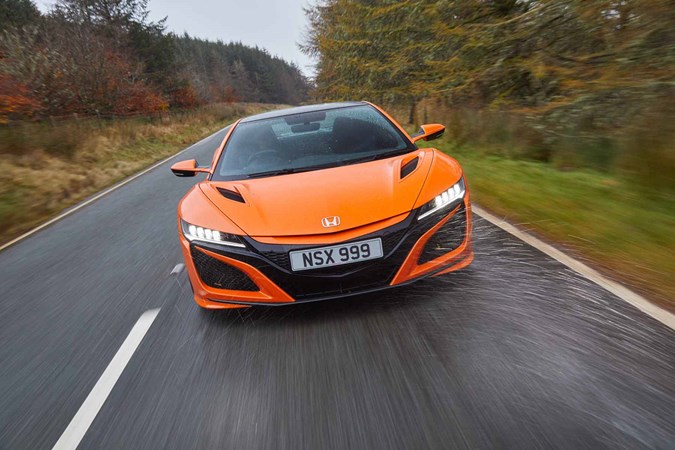
The result of all this electrickery is ferocious in-gear acceleration, accompanied by a manic soundtrack of mechanical whines, turbo whistles and piped-in induction roar. Honda says 0-62mph takes “under three seconds” (that’s as specific as it gets), and top speed is 191mph. Simply put: the NSX feels incredibly fast and urgent, thanks to the almost total lack of lag between flexing the accelerator and forward motion.
Integrated Dynamics System driving mode selector
Helping tune the whole experience is the Integrated Dynamics System (a fancy name for a drive mode selector) offering Quiet, Sport, Sport+ and Track settings. This adjusts the chassis and powertrain, including the steering, brakes, throttle, stability control, dampers, engine, transmission, and all-wheel drive system.
Quiet mode gives a couple of miles of all-electric driving and hushed starts, limiting the engine speed to 4,000rpm and closing the exhaust flaps too. Move up to Sport mode and you can rev all the way to the 7,500rpm redline, and the exhaust gains more volume. You also get intake noise piped into the cabin.
Things get a bit more serious in Sport+, which gives you faster gearshifts, more aggressive throttle response and the noise is ramped up further. Finally there is Track mode which as its name suggests, feels a bit too much for road use. It also unlocks launch control (activated by holding the brake and accelerating) and relaxes the stability control systems too.
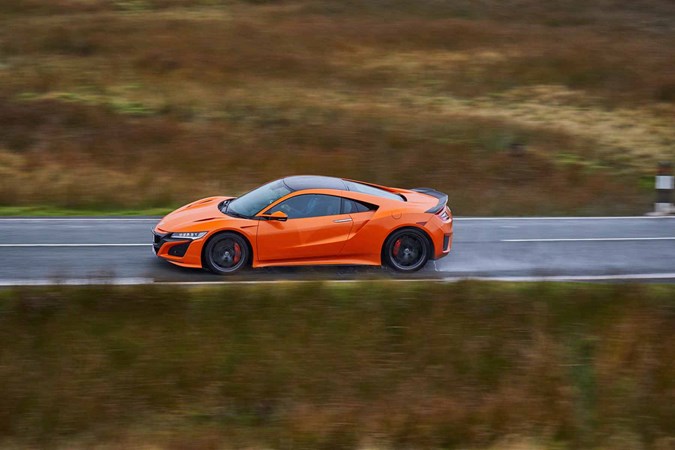
Sport+ gives you faster gearshifts, more aggressive throttle response and even more noise. Finally there is Track mode, which as the name suggests, feels a bit too much for road use; this unlocks extra features such launch control and relaxes the electronic stability control system.
Nine-speed automatic transmission
The gearbox is happy to slur its changes together for refinement and comfort if you’re just cruising, but becomes much sharper and faster in its sportier modes.
It works fine in automatic mode but is sometimes a little too keen to hold on to high revs. You can overcome this by taking manual control and using the paddleshifters behind the steering wheel.
Handling
- Complex powertrain adds weight
- Clever systems in place to flatter you
- Not as organic an experience as before
There’s a lot going on here to help keep you pointing in the right direction. The Honda NSX’s all-wheel drive system provides massive agility in a way that feels quite different to anything else we’ve driven.
Other performance cars with a mechanical limited slip differential can send more power to the outside wheel to help tighten your line around a corner, but only when you’re on the power.
The electric motors on the front axle of the NSX can trim your angle for you when you’re coasting or even on the brakes, meaning bold entry speeds with late braking will be met with a spooky dart towards the apex. It’s quite a compelling experience.
Sharp steering, little bodyroll
A big improvement over the old car is the speed of the steering, with very little need to move your hands from the quarter to three position even in tight maneuverers. It has a well-judged variable ratio set-up though, meaning at motorway speeds that same steering reacts less to twitches of the wheel.
Gladly, it’s actually a well-judged, variable-ratio setup, meaning that despite this twisty road gymnastics, at motorway speeds it reacts less to twitches of the wheel, making the NSX feel stable when you’re travelling quickly.

Teamed with flat handling and those clever motors the NSX turns in with remarkable ferocity, holds its shape well around a corner and then blasts out the other side with the instant torque of its electric powertrain and V6 engine in harmony.
It’s a great thing to drive in a hurry but somehow misses a bit of the old car’s involvement. It’d be undoubtedly rapid around a track but you’ll be left wondering how much of the lap time was down to your driving.
Very clever brakes
The NSX uses an unusual electronic servo between the pedal and the brake calipers, allowing the car to modulate the amount of braking power depending on the circumstances.
In general, bitey supercar brakes perform well on the track but annoy around town, while normal road car brakes offer great modulation but don’t slow you down fast enough on a circuit. This Honda system combines the best of both by dolling out the amount of stopping power it thinks you need based on your speed.
Because the pedal is not physically connected to the brakes we were concerned it would offer no feel, and would be further corrupted by the regenerative system that recoups braking energy to recharge the hybrid system’s batteries. Yet the NSX’s brakes offer great power without feeling unnatural. A remarkable and commendable achievement.
Chassis overhaul in 2019
Responding to criticisms of the NSX being hugely capable but not particularly entertaining, Honda’s engineers went to town on the car’s software and hardware in an effort to dial in some fun.

Specifically facelifted cars feature stiffer stabiliser bars and bushings, as well as new Continental Sport Contact 6 tyres designed specifically for the NSX. More track-focussed Pirelli P Zero Trofeo R tyres are still available as an option.
In terms of software tweaks changes have been made to the hybrid system as well as the power steering and stability control system. Changes to the damper software makes them more comfortable in the softest setting, while retaining the stiffer mode, which does rather beg the question why Honda didn’t apply this setting in the first place.
We’ve not driven the new car on track but on the road at least the NSX felt a lot more rear-driven than before, with the back end of the car breaking away at the slightest provocation. It still offers up stacks of grip but offers much more in the way of throttle adjustment, making you feel right at the heart of the driving process.
Those after some more black and white evidence should be satisfied by the fact the updated NSX is now nearly two seconds faster around the Suzuka Circuit that before.







.jpg)
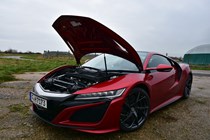
.jpg)
.jpg)
.jpg)
.jpg)
.jpg)
.jpg)
.jpg)
.jpg)
.jpg)
.jpg)
.jpg)
.jpg)
.jpg)
.jpg)
.jpg)
.jpg)
.jpg)
.jpg)
.jpg)
.jpg)
.jpg)
.jpg)
.jpg)
.jpg)
.jpg)
.jpg)
.jpg)
.jpg)
.jpg)
.jpg)
.jpg)
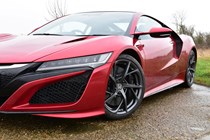
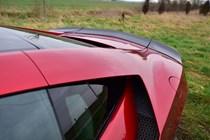



.jpg)
.jpg)
.jpg)
.jpg)
.jpg)
.jpg)
.jpg)
.jpg)
.jpg)
.jpg)
.jpg)
.jpg)
.jpg)

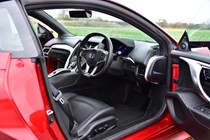
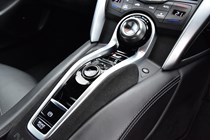

.jpg)
.jpg)
.jpg)
.jpg)
.jpg)
.jpg)
.jpg)
.jpg)
.jpg)
.jpg)

.jpg)
.jpg)

.jpg)





.jpg?quality=50)

.jpg?quality=50)
.jpg?quality=50)
.jpg?quality=50)
.jpg?quality=50)
.jpg?quality=50)
.jpg?quality=50)
.jpg?quality=50)
.jpg?quality=50)
.jpg?quality=50)
.jpg?quality=50)
.jpg?quality=50)
.jpg?quality=50)
.jpg?quality=50)
.jpg?quality=50)
.jpg?quality=50)
.jpg?quality=50)
.jpg?quality=50)
.jpg?quality=50)
.jpg?quality=50)
.jpg?quality=50)
.jpg?quality=50)
.jpg?quality=50)
.jpg?quality=50)
.jpg?quality=50)
.jpg?quality=50)
.jpg?quality=50)
.jpg?quality=50)
.jpg?quality=50)
.jpg?quality=50)
.jpg?quality=50)
.jpg?quality=50)





.jpg?quality=50)
.jpg?quality=50)
.jpg?quality=50)
.jpg?quality=50)
.jpg?quality=50)
.jpg?quality=50)
.jpg?quality=50)
.jpg?quality=50)
.jpg?quality=50)
.jpg?quality=50)
.jpg?quality=50)
.jpg?quality=50)
.jpg?quality=50)




.jpg?quality=50)
.jpg?quality=50)
.jpg?quality=50)
.jpg?quality=50)
.jpg?quality=50)
.jpg?quality=50)
.jpg?quality=50)
.jpg?quality=50)
.jpg?quality=50)
.jpg?quality=50)

.jpg?quality=50)
.jpg?quality=50)

.jpg?quality=50)